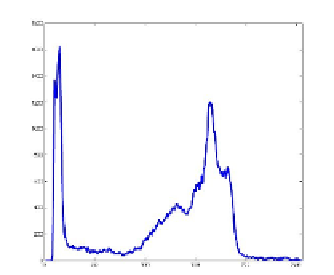Information Technology Reference
In-Depth Information
1
0.95
0.9
0.85
0.8
0.75
0.7
0.65
0.6
0.55
0.5
0
50
100
150
200
250
Fig. 12.7
Histogram of an image and two different membership functions to represent the
background and the object
functions are a way to represent the user's ignorance in choosing the two member-
ship functions used to represent the image (object and background). Therefore, in
our algorithm we will associate to each pixel three numerical values:
•
A value representing its membership to the background, which we interpret as
the expert's knowledge of the membership of the pixel to the background.
•
A value representing its belongingness to the object, which we interpret as the
expert's knowledge of the membership of the pixel to the object.
•
A value representing the expert's ignorance of the membership of the pixel to the
background or to the object. This ignorance hinders the expert from making an
exact construction of the membership functions described in the first two items.
The lower the value of ignorance is, the better the membership function chosen
to represent the membership of that pixel to the background and the one chosen
to represent the membership to the object will be. Evidently, there will be pixels
of the image for which the expert will know exactly their membership to the
background or to the object but there will also be pixels for which the expert is
not able to determine if they belong to the background or to the object.
Under these conditions, if the value of the ignorance function (
G
u
) for a certain
pixel is zero, it means that the expert is positively sure about the belongingness of
the pixel to the background or to the object. However, if the expert does not know
at all whether the pixel belongs to the background or to the object he must represent
its membership to both with the value 0.5, and under these conditions we can say
that the expert has
total
ignorance regarding the membership of the pixel to the
background and the membership of the same pixel to the object.
In [9] ignorance functions are defined in the following way:
2
[
,
]
→
[
,
]
Definition 26.
A function G
u
:
0
1
0
1
is called an ignorance function, if it
satisfies the following conditions:
(
G
u
1
)
G
u
(
x
,
y
)=
G
u
(
y
,
x
)
for all x
,
y
∈
[
0
,
1
]
;
(
G
u
2
)
G
u
(
x
,
y
)=
0
if and only if x
=
1
or y
=
1
;










































